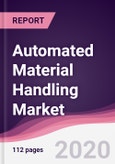What is Automated Material Handling?
Automated Material Handling is any mechanism that brings down or get rid of the requirement of human to entry, exit, categorize, move items with heavy weight, and containers with bulk materials. The Mechanical apparatus used in Automated Material Handling system includes conveyers, singulators, check-in machines, stackers and unstackers.
What are the major applications of Automated Material Handling?
In Manufacturing Sectors, AHS is broadly used to improve the reliability of material delivery along with the bottom line, Plant Environment safety will also be increased and lifting injuries and repetitive task will be decreased.
Automated material Handling systems such as Scanners are used to read the barcodes or a reader to read the RFID tag. Different types of belts, slides, pulleys, chutes, and laser beams are widely used to make sure the containers are not overflow and to make each item to be arranged in a certain order of sequence. There are also many software are used in managing Automated Material Handling Systems.
Competitiveness will get improve by means of operations handled by automating general machine tending. Motion Control Robotics has been improvised and started to utilize in automated material handling systems. All spare parts will be loaded into by flat conveyor, lugged conveyor or any gravity conveyor. This automated system work without any human intervention and round the clock.
Automated Material Handling Market
Market Research and Market Trends of Entrance Matting
Transbotics showcases natural navigation automated lift truck
A new Automatic Guided Vehicle (AGV) lift truck has been recently introduced by Transbotics Corp. The uniqueness about the truck is that it uses natural navigation technology instead of separate reflectors or markers. This Natural navigation technology provides the flexibility for end user organizations to arrange or rearrange the materials wherever the vehicles moves around inside the organization, since, they don’t have specific navigation framework to be installed in the vehicle.
Beamer rolls out new sortation solution
Beamer has recently launched a new innovative sorting techniques which accessible in tilt-tray design and cross-belt, known as BG Sorter. It includes a special features like real-time wireless communications and guarantees high quality in sorting and safety in material handling.
Seegrid introduces self-driving vision-guided pallet truck
Seegrid Corporation, one of the predominant player in industrial automation, has recently inaugurated an auto-driving pallet truck, GP8 Series6 uses smart platform which integrates adjustable, frameless and vision guided vehicles with fleet management. This series have their stereo cameras which acts as similar to human eye which covers 360 degree vision, so, doesn’t need the human intervention to complete the task and eliminates the automation loop but provides better end-to-end solution.
Who are the Major Players in market?
The key players operating in the Automated Material Handling market are Bastian Solutions, Jungheinrich AG, Daifuku Co.Ltd, JBT Corporation, Hyster-Yale Materials, Honeywell Intelligrated System, ABB Group, Beumer Group, Siemens Group and other 10 more companies.
What is our report scope?
The report incorporates in-depth assessment of the competitive landscape, product market sizing, product benchmarking, market trends, product developments, financial analysis, strategic analysis and so on to gauge the impact forces and potential opportunities of the market. Apart from this the report also includes a study of major developments in the market such as product launches, agreements, acquisitions, collaborations, mergers and so on to comprehend the prevailing market dynamics at present and its impact during the forecast period 2017-2023.
Key Takeaways from this Report
Evaluate market potential through analyzing growth rates (CAGR %), Volume (Units) and Value ($M) data given at country level – for product types, end use applications and by different industry verticals.
Understand the different dynamics influencing the market – key driving factors, challenges and hidden opportunities.
Get in-depth insights on your competitor performance – market shares, strategies, financial benchmarking, product benchmarking, SWOT and more.
Analyze the sales and distribution channels across key geographies to improve top-line revenues.
Understand the industry supply chain with a deep-dive on the value augmentation at each step, in order to optimize value and bring efficiencies in your processes.
Get a quick outlook on the market entropy – M&A’s, deals, partnerships, product launches of all key players for the past 4 years.
Evaluate the supply-demand gaps, import-export statistics and regulatory landscape for more than top 20 countries globally for the market.
Table of Contents
Methodology

LOADING...








